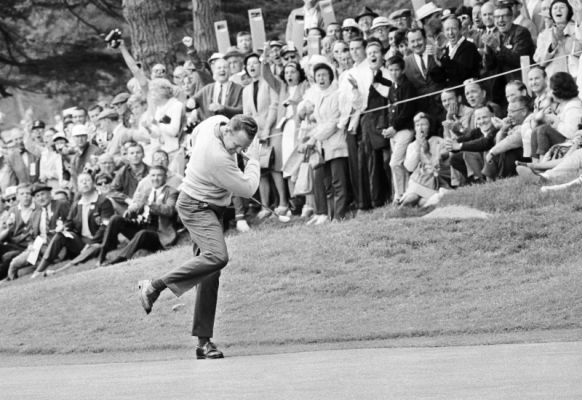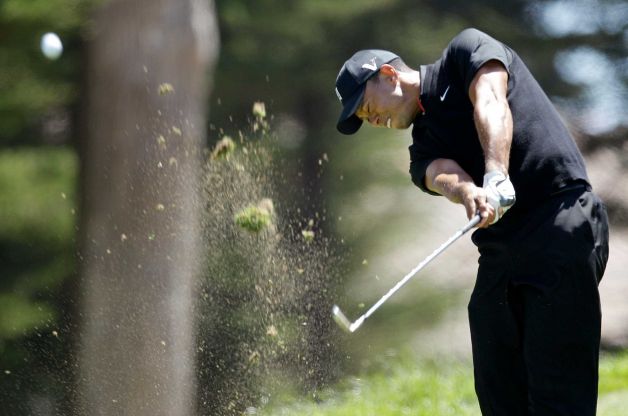Looking Back…Billy Casper Wins 1966 U.S. Open At The Olympic Club
By David Shefter
Some people view the 1966 U.S. Open at The Olympic Club as a complete collapse by Arnold Palmer.

Palmer, after all, had the championship all but sealed with nine holes to play. He led Billy Casper by seven strokes and the storyline immediately shifted to whether the native Pennsylvanian could better Ben Hogan’s 72-hole Open scoring record of 276 set in 1948 at Riviera Country Club in Pacific Palisades, Calif. Palmer had opened the final round with a solid 32 on Olympic’s first nine, but as fate would have it, the inward nine would prove to be The King’s Waterloo.
Casper, then 34, was no stranger to U.S. Open pressure. The California native had won the championship seven years earlier over the challenging layout of Winged Foot Golf Club’s West Course with a brilliant display of putting on some of the game’s toughest greens.

Yet history was not on Casper’s side. Nobody had ever overcome a seven-shot deficit with nine to play. In 1960 at Cherry Hills Country Club in suburban Denver, Palmer trailed 54-hole leader Mike Souchak by from seven strokes before shooting a final-round 65 to win by two shots over amateur Jack Nicklaus.
But that was over 18 holes, not nine.
Palmer started unraveling when he began the second nine with a bogey at the par-4 10th. He would add another bogey at par-3 13th hole. Still, Palmer needed only to play even-par golf the last five holes to secure the win.
The turning point came at the par-3 15th. Casper faced a long, left-to-right breaking birdie putt that he managed to convert for a 2. Palmer made a bogey and suddenly his lead was trimmed to three.
“I never thought I could win until I birdied the 15th hole, even though I was three shots behind with three holes to play,” said Casper. “It’s the only time I felt I could catch him.”
Two more strokes were trimmed at the dogleg-left par-5 16th hole, and Casper finally caught Palmer with a par at the uphill par-4 17th hole after Palmer recorded yet another bogey. Two pars at the closing hole left both combatants tied at 2-under-par 278, the second-lowest 72-hole total ever registered in a U.S. Open, and facing an 18-hole playoff on Monday.
The playoff began just like the final round, with Palmer getting off to a sizzling start, posting a 2-under 33 to Casper’s 35. This time, the par-4 11th hole would prove to be the pivotal turning point. Casper registered a birdie-3 to Palmer’s 5. It was the start of a bogey spree for Palmer, who would eventually shoot a 3-over 73 to Casper’s 1-under 69.
“I beat him pretty solidly on the back nine,” said Casper, who outscored Palmer on that side over the final two days, 66-79. “Coming back … to top Arnold in 1966 … I would say is something to remember.”
Palmer challenged the following year for one more U.S. Open title at Baltusrol Golf Club in Springfield, N.J., but his longtime rival Jack Nicklaus would get the best of him in the final round, shooting a 5-under 65 to break Hogan’s championship scoring record by one stroke. Palmer finished four shots off the pace for his third runner-up showing at the Open. Nicklaus had also edged Palmer in an 18-hole playoff for the 1962 Open at Oakmont (Pa.) Country Club.
Meanwhile, Casper did claim the 1970 Masters for his third and final major championship.
But in 1966, The Olympic Club proved once again to be an omen for the frontrunner. Eleven years earlier, unheralded Jack Fleck caught Hogan with a 72nd-hole birdie. He would then shock Hogan in an 18-hole playoff the next day. Now it was Palmer’s turn to be caught over the final nine holes. When the Open returned to Olympic in 1987, frontrunner Tom Watson succumbed to the less-heralded Scott Simpson. Similar circumstances would fell Payne Stewart 11 years later against Lee Janzen.
One other interesting footnote emerged from that 1966 Open. Johnny Miller, than just a 19-year-old amateur and two years removed from his U.S. Junior Amateur triumph, earned low-amateur honors at his home club. Miller, who posted 290 to share eighth place, was a junior member at Olympic Club and his play that week would portend future success. Seven years later, he posted a final-round 63 at Oakmont C.C. to win his only Open title.



